As a kid, I was always fascinated by this building because it was just my size. It was like a little doll house plopped onto the black top parking lots of the buildings surrounding it on West Florissant in Country Club Hills. When I went back to visit it in 2002 to take the photo above, I was struck by how antiquated the notion of a single doctor working out of a cracker box seems today. For at least the last 30 years, our doctors are bunched together in large office buildings built for just that purpose, and the care within can be just as impersonal and confusing as those buildings.
This 1,152 s.f. building from 1956 was the office of Dr. Hubert S. Pruett (who once played with the St. Louis Browns!). In 1963, the space was labeled The Sheldon Medical Building, as if it were to house more doctors, but it remained the private practice of Dr. Pruett until Dr. Samuel G. Ramirez took over in 1975.
With the Sheldon back in my consciousness, I started noticing the plethora of tiny medical buildings dotting St. Louis. Like the one above, at 9717 Manchester, in Rock Hill. In 1953 it was the office of dentist Albert Thomas. By 1963, chiropractor Elizabeth J. Lochner took over, and took care of patients well into the early 1990s.
There are many intriguing things about these tiny medical buildings. For instance, they tend to be at the far limits of St. Louis City and the inner-ring suburbs, so were built in the mid-century with cars in mind. Private practice doctors followed the population out to St. Louis County, and while their patients were buying bigger homes, the doctors were content with less than 2,000 s.f.
Most interesting of all is that even in the midst of our square foot gluttony, most of these match boxes are still used today, and quite often the use stays in the health care realm.
This office at 9846 Manchester in Rock Hill fits the Tiny Medical Building M.O., but actually opened in 1952 as Woodard Rug Cleaners. But by 1963, the true nature of this building was realized when Alfred W. Moller opened his veterinarian practice. Hey, human or animal, it’s still medical care, right? It became West Side Animal Clinic in 1972, and as you can see, they are still there to this very day.
An early example of what would become the standard of group physicians is shown above, at 2730 Watson in the Clifton Heights neighborhood of South St. Louis City. From 1958 – 1980 it housed multiple physicians and optometrists (for humans), then it became a veterinary clinical laboratory until the mid-1990s. Today, the office facing onto Southwest Avenue belongs to a chiropractor, so it went full circle back to the humans.
These medical offices also highlight the rapidly changing nature of 20th century American medical practice, which is really more the story of health insurance. Up to the 1930s, doctors made house-calls, but with the advent of Blue Cross & Blue Shield insurance from 1930-1940, companies could buy into tax-free policies for their employees, and the need for more doctors increased. With this growth of supply and demand, commercial insurance companies were finally ready to join in, increasing the number of insured from 20,662,000 in 1940 to nearly 142,334,000 in 1950.
These tiny medical offices were built for general practitioners who finally had a chance to make real money and care for their patients with total autonomy. But by 1964, the numbers of doctors going into general practice were dwindling, with the focus moving over to medical specialists. A solution for both general and specialized medicine to financially prosper was enacted in 1973 as the Health Maintenance Organization, and became the large HMO buildings so many of us visit today.
This huge shift in the medical industry to group health care made these tiny medical buildings obsolete for private practice. It’s a deep irony that some of these buildings now house medical specialists, like the office (above) at 3185 Hampton in South St. Louis City. But here’s a spin on this type of building: it was built in 1962 for American National Insurance, who used the building until 1990, when it became the City Spinal Center. So even when the contents start off differently, these mid-century modern cubes just broadcast a medical nature. Or actually, it would be merely a snapshot, as this medical period only lasted roughly 15 years.
I am continually impressed with the adaptive re-use of these tiny buildings; most don’t stay vacant for too long. Then again, depending on where they are, they are also highly vulnerable to demolition. This little gem of concrete, cubist mid-century modernism (above) at 7810 Natural Bridge Road was being prepped for demo when I took this photo in 2005. It started life as a doctor’s office, and by the end of its run, it held a carpenter’s shop and a travel agency. So, the building was still useful, but it was in the area surrounding the University of Missouri-St. Louis, and was taken down for some vague reason still unresolved.
But the majority of tiny medical buildings remain to this day. Shown above is the place built for dentist Conrad J. Zoeller in 1954, at 9300 Gravois Road in Afton, MO. He worked from this 748 s.f. office until the mid-1990s, and it was recently a hearing center until it – or rather its parking lot – found a whole new use as a produce stand!
Today, because of the health insurance industry, the medical profession is in worse shape than its former buildings. Doctors can’t practice as responsibly and freely as they did when in these little stand-alone buildings, while their buildings keep finding a way to help humans and their pets.
Even the little building on West Florissant that first opened my eyes to this short chapter of medical architecture still has a healthy, beating heart. It is now a hair care center, ingeniously divided up as a barber shop through one entrance and a beauty salon through the other. Here’s hoping that in the next couple of years, our health care system can transition into adaptive re-use as flexibly as its former buildings do.
.

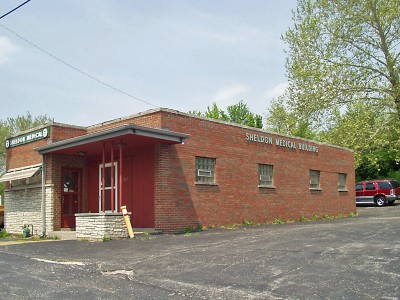
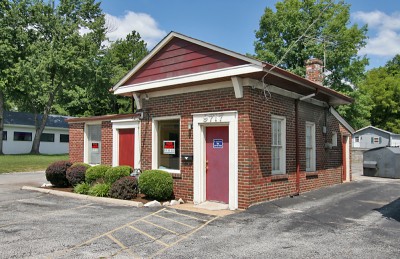
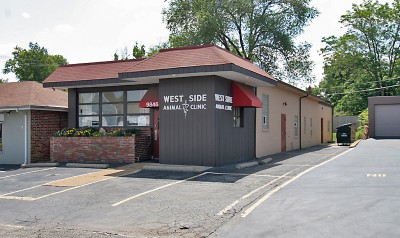

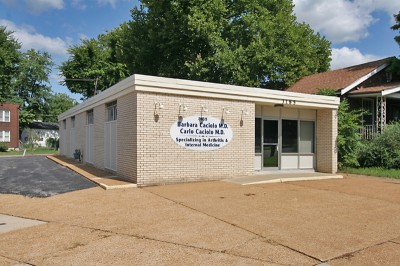
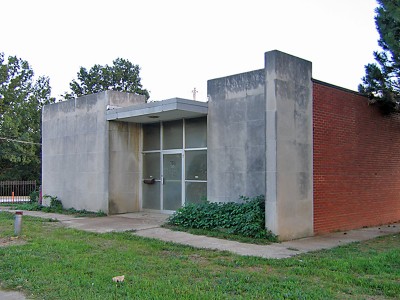
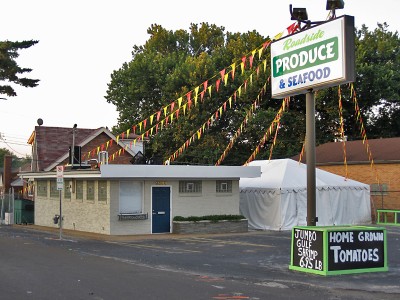
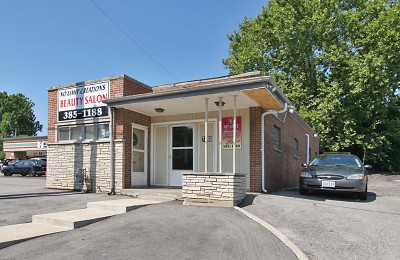
B.E.L.T. is fast becoming my not-so-new “healthy” addiction. I’m hoping one of those times when I was thoroughly engrossed in yet another classic Chicago Art Institute photography exhibit on retro cityscapes, Mies van der Rohe, or perhaps a 3-D architectural retrospective, that you were in the room with me!
Here are two additional teensy professional buildings from my home turf, U.City/Clayton, both of which were dental offices at one time:
The Harry Dalin Dental Office, now La Pizza,
near Delmar and Old Bonhomme, at 8137 Delmar.
The Sherman LeMaster Dental Office 8027 Clayton Rd., now vacant thanks to a tax maneuver by the trustees of his estate, located immediately west of where Pfeiffer’s Bakery once stood, on the north side of Clayton Road across from a former Howard Johnson’s, technically but legally part of Clayton’s Davis Place subdivision, but because the post office won’t split streets when assigning zip codes, it “annoyingly” carries Richmond Heights’63117 instead of Clayton’s 63105. LOL!
I tripped across your blog while looking for a picture of River Des Peres and giggled, realizing how local you were to my growing up. In a recent trip “home” to my mothers house I did notice the fruit and seafood stand and thought the same thing about Sushi in the midwest as I do a seafood stand on Gravois road.
I love the buildings that you have in this post, they are devine, I miss so many of them and could not point the location out by sight but do recall them in my memory.
thanks, this was fun for me to see.
Great story, Toby! You have a real eye for the sublime in our built environments. Haven’t read BELT is awhile, but a friend cross-posted this entry to my facebook page. I really enjoyed reading it. –Best, Joseph Heathcott
Cool–I like the subject matter:) Of course, nice photos! There is another that you would like, too; it reminds me of Coral Court’s styling. It is on Gravois just west of Sappington Rd. on the north side of the street.